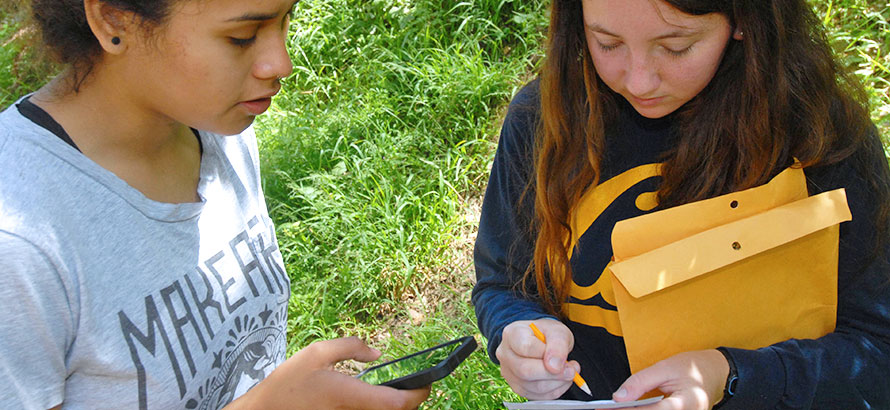
Laura Perez Olivera (L), CNR undergraduate and Ingrid Rosenthal (R), Albany High School student intern, collect California bay laurel leaves and record GPS location data in Strawberry Canyon for the 2014 SOD Blitz Survey Project. Attribution: Matteo Garbelotto Lab, UC Berkeley.
Sudden Oak Death (SOD), a serious exotic disease, is threatening the survival of tanoak and several oak species in California. Currently SOD is found in the wildlands of 14 coastal California counties, from Monterey to Humboldt. While patchy in distribution, with each passing year, the swath of infection continues to become more contiguous.
Researchers have discovered that Phytophthora ramorum, the pathogen that causes SOD, spreads most often on infected California bay laurel leaves. Symptomatic bay leaves are often the first sign that SOD has arrived at a location, and generally precede oak infections. Some management options are available (sanitation, chemical preventative treatments, bay removal), but they are effective only if implemented before oaks and tanoaks are infected; hence, timely detection of the disease on bay laurel leaves is key for a successful proactive attempt to slow down the SOD epidemic.
Matteo Garbelotto's Forestry & Mycology Lab is working to identify areas where the infestation may be mild enough to justify proactive management. Calling upon community volunteers, the lab runs SOD-blitzes: "citizen scientists" collect and submit leaf samples and then the lab uses DNA-based analyses to determine the presence or absence of Sudden Oak Death. Every fall, the lab produces detailed local maps of disease distribution.
Garbelott's lab has developed SODmap mobile, which allows users to view the distribution of Sudden Oak Death using a smartphone or tablet. The app interfaces with the SODmap database and allows you to visualize both SOD-positive and SOD-negative trees, based on laboratory results. And through their work, the lab has also discovered that drought years reduce the survival of SOD to a smaller number of 'refuge' trees, opening up new strategies for SOD management.
